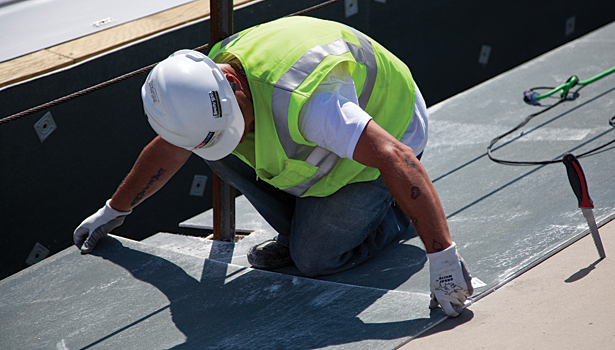Cover Boards: The One Roofing Product You Should be Using

As part of a low-slope roofing system, I think one of the most underrated and underappreciated components is the cover board. It’s left out altogether in many cases, which I believe is a shame.
There are many types of cover boards, and I realize I’m lumping them all into one category, which some will argue is inappropriate. For the sake of this brief note, however, let’s just set that aside.
There are many reasons you want to include a cover board. For the building owner, the difference is going to be the thermal and moisture performance of the finished product. With most low-slope roofing systems going over metal decks, the base layers of the system are to provide thermal protection and a suitable substrate for the roof membrane covering. The base layer is also part of the air, vapor, moisture, and fire protection scheme for the building.
To accomplish this, the typical specification calls for enough layers of polyiso roof insulation to meet code for the prescribed thermal resistance value. It’s always bothered me a little that the thermal resistance requirements are recognized equally for insulation installed in one layer, or two, or more. They’re recognized equally whether they are mechanically fastened or applied with adhesives, at least on paper.
But are they equal in terms of downstream performance of the roofing system and in terms of actual thermal resistance?
To begin with, I’ve always believed that multiple layers of roof insulation are far superior to single layers. Multiple layers of roof insulation are going to provide closer to a monolithic system than one as the seams are covered by staggering joints one layer over the other. It would be difficult to count the dollars lost in thermal efficiency of the system over the life of the roof. A small, incremental difference, but over the expected life of the membrane (and subsequent roof coverings), it may be significant. A low-slope roofing system with a cover board always delivers two layers, even if the thermal requirement is met with one layer of polyiso. A cover board may also provide nominal protection for the polyiso.
I also believe that the quality of the substrate the roofing membrane comes to rest on is more important than many owners may realize. In small, incremental ways, such as building movement and prevailing winds, the wear on the membrane over time should be less when it rests on a stable, firm substrate. And how about the thermal break you get when the metal fasteners and plates are covered by an adhesive-installed cover board? It seems like a shame to put all that insulation on just to run screws through it, telescoping the heat or cold (and moisture?) from the outside to inside the space. Compared side-by-side, I do not see how covering the fastening system, even by a minimum thickness cover board, would not perform the best.
I realize adding a cover board isn’t the least expensive route to a completed low-slope roofing assembly. I am, however, suggesting that you consider the addition of a cover board anytime it’s left out of a specification. The alternate may be acceptable to the well-educated owner and, I believe, will result in a better finished product.
